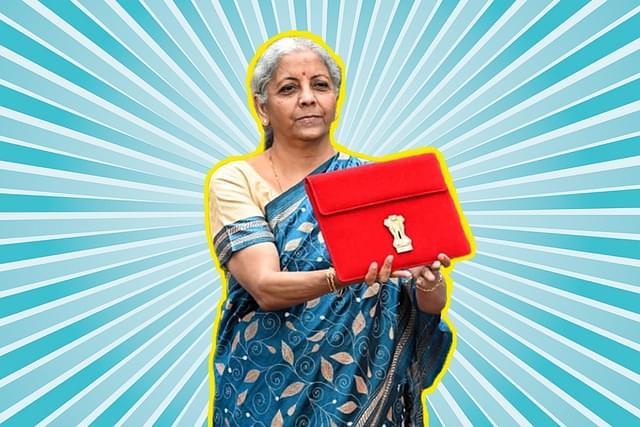Economy
No Frill, No Thrill, Just Chill: Nirmala Sitharaman’s ‘Interim Budget 2024’
Pratim Ranjan Bose
Feb 01, 2024, 03:52 PM | Updated 03:51 PM IST
Save & read from anywhere!
Bookmark stories for easy access on any device or the Swarajya app.

An ideal interim budget that is short in length, bereft of any frills but not short of confidence and commitment to build a strong economy. That explains the vote-on-account Union Budget 2024.
This was expected from a confident government, leading a confident India to the Lok Sabha election in 2024. Finance minister Nirmala Sitharaman lived up to the expectation by delivering her shortest budget speech yet.
There is every reason for the Narendra Modi government to feel confident. It has not only steered the economy to safety during the most difficult phase in world history since World War-II, but ensured that India outperforms its peers.
Restricting the fiscal deficit at 5.8 percent, less than the targeted 5.9 percent in 2023-24 and announcing a steep target of 5.1 percent for 2024-25, is laudable in such difficult times when the global trade is most uncertain.
From the Ukraine-Russia conflict to the latest Israel-Hamas conflict, a struggling Chinese economy, the hangover of the ill-conceived fiscal policies of the US and Europe during the pandemic and, last but not least, the intensification of the tariff war – the global scenario is not conducive to growth.
Yet, India has been consistently beating growth estimates for nearly three years now, inflation is under control, and consumer confidence has been rising steadily since the dip in 2020.
From free foodgrains to nearly two-thirds of the population to housing for the poor, improved access to healthcare and cash transfers to the farmers - social welfare is scaled up to unprecedented levels but without compromising fiscal balance.
The finance minister explained how direct cash transfers helped the government plug leakages worth Rs 2,70,000 crores (over $32 billion). The benefits went to record government spending in infrastructure building, paving the way for investment-led growth.
Better physical and digital infrastructure coupled with a series of high-profile reforms reopened the taps of private capital expenditure. The inflow of foreign direct investment (FDI) doubled.
“The FDI inflow during 2014-23 was USD 596 billion marking a golden era. That is twice the inflow during 2005-14,” the finance minister said. And that is just the beginning.
Ms Sitharaman started off her speech by saying that the next five years will usher in unprecedented growth and development in India. A part of which is already felt through the big bang arrival of top brands like Apple.
There is no doubt that an India story is unfolding and the proof of the pudding lies in the market. There was a time when India’s stock indices were hugely dependent on foreign institutional investors (FII). An exodus of foreign investment meant collapse, but not anymore.
The BSE Sensex increased by nearly three-fold since Modi assumed office in June 2014. The index grew by 75 percent during Modi’s second term that coincided with maximum global uncertainty.
The last two years saw foreign investors exit from stock markets around the world and head for the US. Yet the Indian market grew from strength to strength. Domestic investors have taken charge of the market.
This is a new India that makes decisions independent of foreign influence. From sourcing crude oil from Russia ignoring criticism of the West, to resorting to tit-for-tat in response to Canada’s outrageous allegations – examples are aplenty.
Unfortunately, India’s Opposition is failing to recognise the rise of a new India and is sounding repetitive in their allegations. Some of these allegations are hilarious.
One critic from Congress, for example, found an exception in the higher share of indirect tax in the total collections. He forgot that the tax buoyancy of the economy increased substantially, and that was the aim of the tax reforms.
Should we go back to the socialistic model of charging high direct tax and ending up with low collections and low growth?
Save & read from anywhere!
Bookmark stories for easy access on any device or the Swarajya app.
Support Swarajya's 50 Ground Reports Project & Sponsor A Story
Every general election Swarajya does a 50 ground reports project.
Aimed only at serious readers and those who appreciate the nuances of political undercurrents, the project provides a sense of India's electoral landscape. As you know, these reports are produced after considerable investment of travel, time and effort on the ground.
This time too we've kicked off the project in style and have covered over 30 constituencies already. If you're someone who appreciates such work and have enjoyed our coverage please consider sponsoring a ground report for just Rs 2999 to Rs 19,999 - it goes a long way in helping us produce more quality reportage.
You can also back this project by becoming a subscriber for as little as Rs 999 - so do click on this links and choose a plan that suits you and back us.
Click below to contribute.





